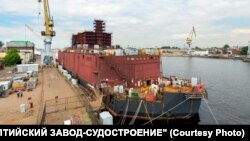ST. PETERSBURG, Russia -- Ecologists in Russia's northern capital are raising the alarm over government plans to fuel a floating nuclear power plant just 2 kilometers from the heart of the city.
Officials have been saying since December that they are nearly ready to begin fueling the Akademik Lomonosov, the country's first-ever ship-borne nuclear-power station, which is scheduled to be deployed at Vilyuchinsk on the Far Eastern Kamchatka Peninsula in 2019. Because the process is shrouded in secrecy and the government has ignored requests for information, it is unclear what the status of the fueling process currently is.
"From this floating nuclear power plant to the city's mining institute [for example] is probably only about 500 meters," Rashid Alimov, director of energy programs for Greenpeace Russia, told RFE/RL. "The historical center is densely populated. We have to exclude even the thought of an accident. That is why we have written to the governor. … According to the law, carrying out such operations at the Baltic Shipyard must be approved by the city, evacuation plans have to be drawn up. We have asked the municipal authorities about this."
The keel of the Akademik Lomonosov was laid in 2007 in the Far Northern shipyard of Sevmash in Severodvinsk and was originally intended to power Sevmash itself. However, in 2008, it was moved to the Baltic Shipyard in St. Petersburg for the installation of its two reactors, which are modified naval propulsion reactors. In Kamchatka, it is intended to replace the Bilibino nuclear-power plant, which is scheduled to begin decommissioning in 2019. Its construction is being overseen by the Rosatom state nuclear-energy corporation.
Independent nuclear-energy analyst Aleksei Shchukin, who spent more than 30 years working on nuclear-powered icebreakers, told RFE/RL that the fueling operation presents risks. Although the reactors are based on designs developed in the 1960s, the configuration on the Akademik Lomonosov is unique and untested.
"That is why I think there is no point in taking a risk and fueling the reactors in the center of a huge city," Shchukin said. "This is very dangerous. They could take the vessel to Murmansk or Arkhangelsk, where there are bases for repairing and refueling nuclear vessels. That would be much safer."
Authorities have ignored requests to find out why they insist on conducting the refueling -- and possibly other testing -- in St. Petersburg, a UNESCO-protected World Heritage Site with a population of just under 5 million.
Previous Incidents
Oleg Bodrov, chairman of the Public Ecological Council of the Southern Shore of the Gulf of Finland, notes that the original reactor design was tested in the town of Sosnovy Bor, some 40 kilometers from St. Petersburg, in the 1970s.
The government acknowledged one accident in 1972 in which a reactor shield was breached but, according to improbable official reports, no radiation was released. In another incident in 1979, an entire building was destroyed in an explosion and two workers were killed. Both incidents were classified as secret at the time and only made public many years later.
"I find it strange behavior on the part of our lawmakers that they don't demand information and proof of the safety of these actions," Bodrov said. "As a resident of the Baltic region, I would like to get such proof -- in a form that is understandable to the public and to officials. But at present, such information is absent."
Bodrov is calling for public hearings with the participation of Rosatom, municipal authorities, the ecology commissions of the city and regional legislatures, and representatives of the public.
Floating nuclear power stations have been touted as an effective way to bring electricity and heating to remote areas, particularly Russia's Arctic region. Many also see them as a way of powering offshore oil-and-gas exploration. The United States converted a World War II-era transport ship into a mobile nuclear power plant in the 1960s and until 1975 it was used to power the locks in the Panama Canal.
Such floating power plants have been sharply criticized by environmentalists, who warn that they would likely be cut off from backup power in the event of an accident due to their remote locations. Environmentalists are also concerned that Russia might just dump a stricken plant into the ocean, as Moscow did with the reactors of numerous Soviet-era nuclear submarines.
Soviet-Era Dumping
According to a 1993 report commissioned by then-Russian President Boris Yeltsin, the Soviet Union dumped 16 nuclear reactors into the Kara Sea and two into the Sea of Japan. According to the report itself, the findings amount to a startling confession of how international agreements "were consciously broken on numerous occasions" by Moscow.
Nonetheless, many countries are interested in the technology, and Moscow views the Akademik Lomonosov as a potentially lucrative prototype. China has announced plans for as many as 20 of them, some of which could be stationed in the volatile and disputed South China Sea.
"I have a TASS report from the latest Arctic Forum in which they say they are doing everything possible to have this plant working in Chukotka by 2019," St. Petersburg activist Alimov said. "They say it will give us the chance to build more such projects not only in Russia but also to export them. But before they can go out to foreign markets, they need to test this technology at home. I definitely think this project is not being done for the sake of the people in Chuktoka but in order to have a working model to show to potential foreign clients."
















